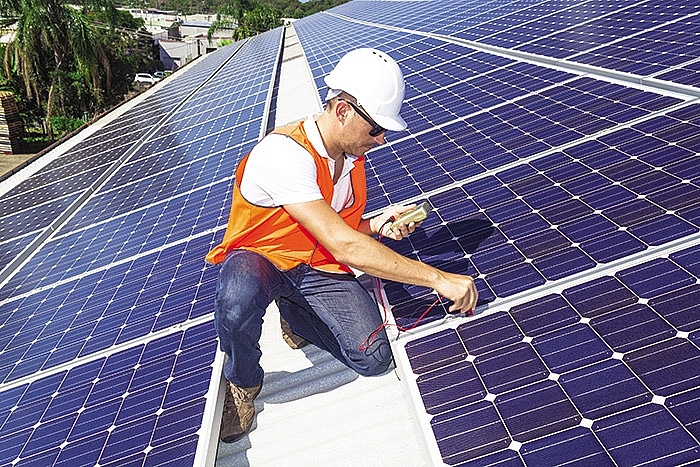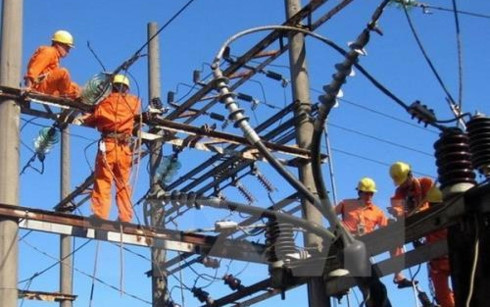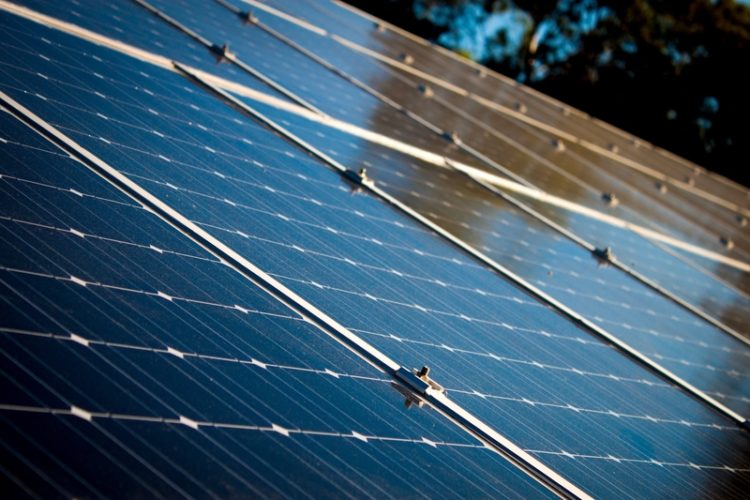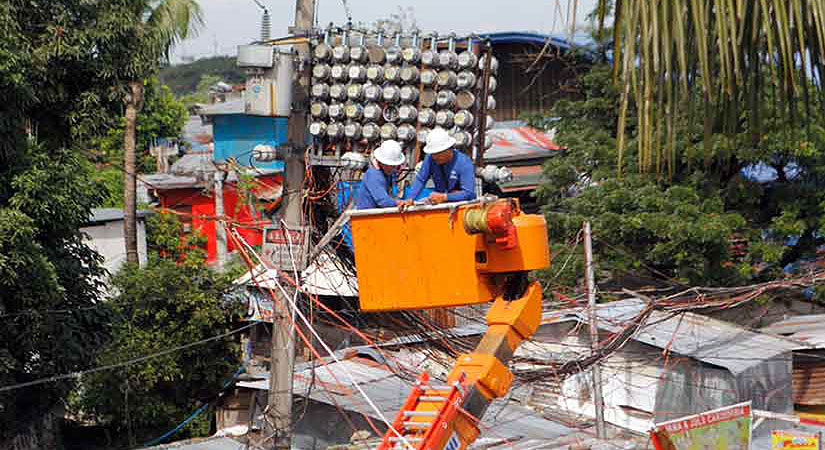For five months, Mac Nhu Lai, a 57-year-old resident in Ho Chi Minh City has been using a three kilowatt-peak (kWp) rooftop solar photovoltaic system called BigKilowatt. The system saved 30 per cent on his electricity bill and increased his income by selling electricity back to the national power grid. “Reducing the electricity bill, the solar rooftop panels help reduce our environmental footprint,” Lai said.
Solar rooftop systems became popular in Vietnam. By installing solar panels and a green roof, owners can save costs and enjoy the socio-environmental benefits of a living roof.
Racing to rooftop
The Vietnamese commercial and industrial sectors has shown a lot of interest in solar rooftop panels.
The 2015-2018 period has seen a number of investments and investment announcements for new or expanded PV module and cell manufacturing capacities. These investments are partly made by local Vietnamese investors such as the expansion of the existing Red Sun module manufacturing or the Solar BK/IREX module and cell manufacturing plants, but feature mostly foreign (mainly Chinese) investors such as Canadian Solar Inc., CSUN, Boviet, Vietnam Sunergy JSC or Vina Solar.
The power market is witnessing a boom in solar power projects as local and foreign investors are racing to reap the benefits of the 9.35 US cent feed-in-tariff (FiT).
The latest data shows that a total of 332 solar projects have been registered with the total capacity of 26,290 megawatt peak (MWp), including 121 projects (7,234MWp total capacity) that will begin to generate electricity by 2020 and 211 (13,069MWp) awaiting approval. These figures have far exceeded the targets of the revised Power Development Plan VII. Additionally, more than 800 small-scale rooftop solar power projects with a combined capacity of nearly 11.6MW have been developed.
The installed capacity connected to the grid is dominated by a rather small number of medium-sized rooftop systems, such as the installations of Intel Corporation in Ho Chi Minh City (220kWp), Big C Green Market in the southern province of Binh Duong (212kWp), PUMA/Avery Dennison in the Mekong Delta province of Long An (100kWp), Deutsche Bekleidungswerke (DBW) in Long An (165kWp) or the National Conference Hall (154kWp), the UN building (119kWp), and the new National Assembly building (50kWp) or the building of the Ministry of Industry and Trade (MoIT – 22kWp) in Hanoi.
At its exhibition booth on the side-lines of the recently-held Vietnam Economic Forum 2019, Mai Van Trung, business development director of SolarBK, told VIR that last year, SolarBK deployed more than 300 projects with a total capacity exceeding 3MWp. In terms of production, SolarBK’s member IREX also contributes to the domestic and foreign markets with a total of more than 50MWp of panels and photovoltaic cells.
From July 2018, SolarBK launched the BigK 2-10kWp solution for households, which exceeded their wildest expectations by occupying 46 per cent of the market for household solution packages in five months.
Pham Trong Quy Chau, director of TTC Energy JSC, also said that the roofs of companies, factories, and apartments have great potential to install solar roof systems. Currently, this company has been renting rooftop space and installing solar panels to then resell the generated energy at a lower price than the utility company.
According to renewable expert Phan Hieu Hien, if only two million roofs in Vietnam were installed with 10kW solar roof panels, coal usage would be reduced by 16 million tonnes per year (worth $3-4 billion) at coal-fired power plants.
Rooftop solar panels have never been more affordable for home and business owners and communities, and they can now help households halve their monthly electricity bills, while contributing to environmental protection. The payback period of five or six years, especially in the south of Vietnam, makes for a promising prospect for international companies, according to Rainer Brohm, a renewable energy expert.
Commercial and industrial solar PV rooftop applications have great development potential and promise interesting investment opportunities for the private sector in Vietnam. Besides households, deploying solar energy at production sites would help manufacturing industries improve the reliability of their power supply and reduce the demand for non-renewable power. This would also bring significant savings for the commercial and industrial sectors in terms of electricity consumption due to high tariffs during peak hours and the cross subsidisation policy charging large consumers more to subsidise smaller ones.
Green trends and 4.0 tech
Nguy Thi Khanh, director of GreenID, the co-ordinator of the Vietnam Sustainable Energy Alliance, said that a greenhouse programme is underway to encourage the installation of solar system on houses’ roofs.
She stated that solar power technology is reliable and cheaper than fossil fuel, and is better for both the environment and human health.
The rising popularity of distributed energy sources like rooftop solar has given end-consumers an opportunity to produce electricity too. No longer just consumers, they are also electricity producers, hence becoming “prosumers.” This is a recent but popular phenomenon.
The high power demand is urging the sector to adapt to an expected explosion in independent power generation – including from households with rooftop solar panels. A winning combination of smart grid, distributed renewable energy sources, and blockchain could trigger an energy revolution the likes of which have never been seen before. It can be the beginning of an era where energy independence is a reality.
Blockchain enables so-called “peer-to-peer” transactions. With this type of transaction, every participant in a network can transact directly with every other network participant, without involving a third-party intermediary. The innovation behind blockchain is that transactions are no longer stored in a central database, but distributed to all participating computers, which store the data locally. The first relevant blockchain application was the Bitcoin cryptocurrency. Over recent years, Bitcoin has become the basis for other blockchain applications, most of which are currently being developed in finance. A number of businesses and initiatives have recently been launched to apply the blockchain principle to other industries, including the energy sector. Blockchain applications are very promising, but they are still at an early stage of development.
Trung from SolarBK told VIR that end-users who directly trade electricity with each other get a better rate than from the utility, while the buyer also gets the energy at a discounted rate.
“Peer-to-peer energy trading is becoming a reality with the help of blockchain technology. Most energy transactions are complex and cumbersome due to the involvement of many parties and regulations. Blockchain can straightaway remove the complexities and let end users deal with each other, while still providing them a secure environment to do so,” said Trung, adding that SolarBK is preparing to apply 4.0 technologies after collecting a database for four years.
Vietnam has expansive solar resources that could be used to successfully develop the solar energy sector. Current scientific estimates of the overall solar resources in Vietnam state an average of 4-5kWh per square metre per day in the southern, central, and partially even northern Vietnam – totalling 1,460-1,825 kilowatt hour (kWh) per sq.m per year – and average peak irradiation of up to 5.5kWhper sq.m per day in some southern areas (totalling up to 2,000kWh per sq.m per year). These solar irradiation levels are comparable to most countries in the region, including developed solar markets such as China, Thailand or the Philippines, as well as to international solar markets, such as Spain and Italy.












